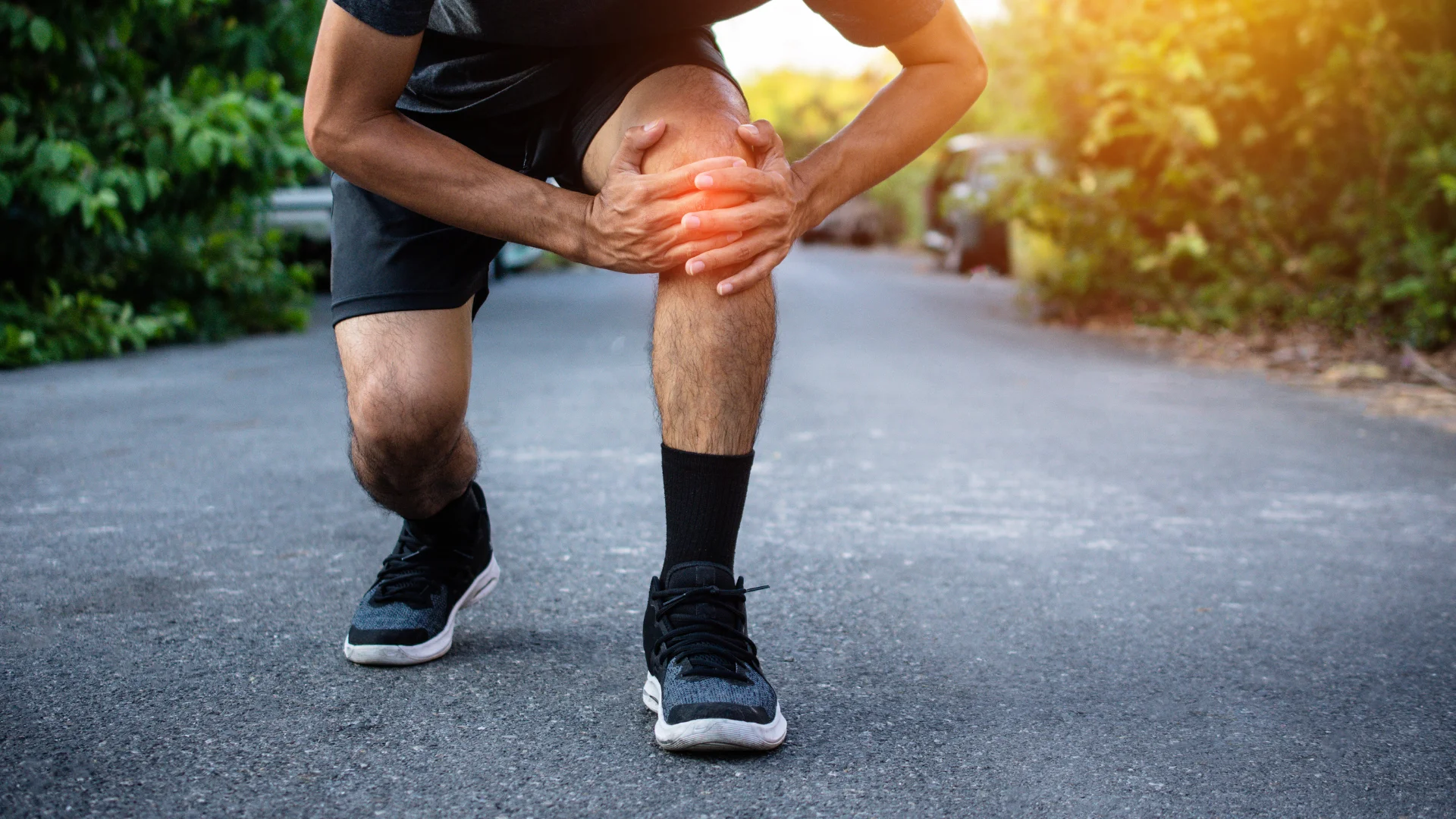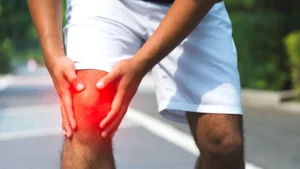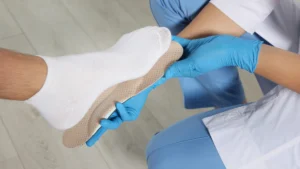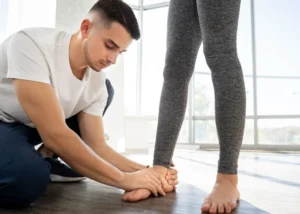Your feet aren’t just feet—they’re the foundation of your entire body.
When they’re out of alignment, everything above them suffers. That’s the essence of the Foot-Knee-Back connection. From ankle instability to spinal discomfort, the chain reaction starts at the ground level. At Custom Orthopedic & The Walk Shoppe in Edmonton, we’ve helped thousands regain proper posture, reduce pain, and move more freely—all starting with custom orthotics.
Let’s break down how the Foot-Knee-Back relationship works—and how orthotics are your most underrated tool for whole-body relief.
The Biomechanical Symphony: How Feet Align to Impact Posture

Your feet serve as the foundation of your body’s alignment, affecting posture from the ground up. When your feet are correctly aligned, they support your entire skeletal structure, balancing weight distribution and stabilizing the spine. Misalignment can lead to compensatory movements that extend tension and discomfort throughout your body, impacting not just your posture but also your overall comfort and mobility.
The Mechanics of Foot Function: From Arch to Heel
The arch of your foot plays a vital role in absorbing shock and distributing forces as you walk or run. When you take a step, the heel strikes the ground first, followed by the arch and the toes. This complex interaction allows for smooth movement while minimizing impact on your joints. If your arch is too high or too low, it can lead to inefficiencies in this movement, resulting in discomfort and strain in your feet and beyond.
The Chain Reaction: Foot Misalignment and Its Ripple Effect
Misalignment in your feet does not occur in isolation; it triggers a chain reaction that affects your entire body. For instance, overpronation, where your foot rolls inward, can lead to knee pain from improper tracking of the patella. This misalignment can escalate to hip issues and lower back pain, as your body compensates for the instability. Each link in this biomechanical chain is interconnected, making it vital to address foot dysfunction early to prevent widespread discomfort.
Consider the impact of a common issue like flat feet. This condition often leads to compensatory movements in the knees and hips, which can spiral into chronic issues such as IT band syndrome or lower back strain. Studies show that individuals with flat feet are at a higher risk for developing joint problems, emphasizing the necessity of addressing foot alignment. Orthotics can effectively support your feet, helping to restore proper alignment and stabilize your entire kinetic chain, reducing the risk of secondary pain and dysfunction throughout your body.
Decoding the Pain: How Poor Foot Health Affects Knees and Back

Whether it’s collapsed arches, overpronation, or joint instability, the body compensates. That compensation often shows up as tight hip flexors, strained lower back muscles, and altered posture. Over time, these imbalances can lead to chronic conditions like sciatica, where nerve irritation in the lumbar spine causes pain to radiate down the leg.
Poor foot health can lead to a cascade of issues in your knees and back. Imbalances and improper mechanics in your feet often result in misalignment throughout your lower body, causing increased strain on the knee joints and the spine. As one part of the kinetic chain falters, compensatory movements take over, frequently resulting in pain and discomfort that can impair daily activities and diminish your quality of life.
The Connection Between Foot Imbalance and Knee Stress
Foot imbalances, such as overpronation or high arches, can create excessive stress on your knees. The knee joint relies on proper alignment at the foot level; any deviation can lead to abnormal tracking of the patella, causing conditions like patellofemoral syndrome or even osteoarthritis over time. This altered gait pattern places undue pressure on the cartilage, leading to inflammation and pain in the knee.
The Back-Story: Why Foot Issues Lead to Chronic Back Pain
Foot problems often manifest as chronic back pain due to the interconnectedness of your body’s musculoskeletal system. Misalignments in your feet can shift your pelvis, which in turn affects the lumbar spine’s posture. Over time, this altered alignment can lead to muscle imbalances and strain in the back, creating a cycle of pain that can be difficult to break without addressing the underlying foot issues.
Foot issues often create a ripple effect that goes beyond localized discomfort. For example, if you have flat feet, your body may compensate by tightening hip flexors and lower back muscles to maintain posture and balance. This discord can result in chronic conditions like sciatica, where nerve irritation in the lower back leads to pain radiating down your leg. Addressing foot health through orthotics can help restore balance, thereby alleviating the downstream effects on your knees and back, promoting overall body wellness.
Orthotics Unplugged: The Role of Custom Solutions in Restoring Balance
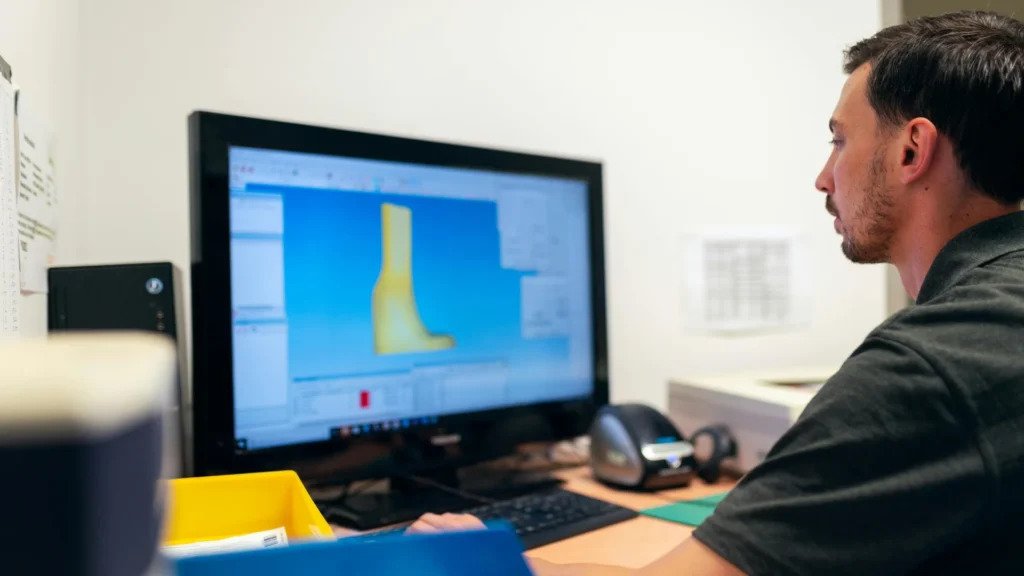
Custom orthotics play a pivotal role in restoring balance by providing personalized support tailored to your unique foot structure and functional needs. Unlike generic solutions, these customized devices address specific imbalances and positioning, allowing your body to function optimally. They help to redistribute pressure, align joints, and improve overall stability, enabling movements that are not only efficient but also pain-free.
Types of Orthotics: From Over-the-Counter to Tailored Solutions
Orthotics range from over-the-counter options available at local stores to bespoke solutions created through professional assessment. Each type serves distinct purposes based on your needs and foot shape.
- Over-the-Counter: Typically pre-made, these provide basic support for common issues.
- Custom Molded: Tailored from a foot cast, these orthotics cater to specific biomechanical conditions.
- Functional: Designed to control abnormal motion, often used for athletes.
- Accommodative: Focused on providing padding and support for existing foot conditions.
- Perceiving your body’s nuances in movement can significantly enhance your overall function.
| Type of Orthotic | Key Characteristics |
| Over-the-Counter | General support, limited customization |
| Custom Molded | Exact fit based on foot structure |
| Functional | Aimed at controlling movement |
| Accommodative | Provide comfort and alleviate pressure |
| Sport-specific | Enhance performance for athletic activities |
The Technology Behind Orthotics: How They Correct Gait and Posture
Modern orthotics incorporate advanced materials and design principles that enhance their effectiveness in correcting gait and posture. Innovations like 3D printing allow for precise replication of your foot’s unique contours, while shock-absorbing materials can optimize comfort and support. By redistributing weight and correcting alignment, these devices facilitate proper biomechanics, reducing strain on your knees and back while promoting better overall movement.
Results in Motion: Real-Life Transformations with Orthotic Support
Individuals experiencing chronic pain have reported remarkable transformations after integrating orthotics into their daily routines. These supportive devices not only alleviate discomfort but also enhance mobility and overall function. Users frequently note improvements in daily activities, from walking and running to standing for extended periods. By redistributing pressure and aligning your feet properly, orthotics create a ripple effect, positively influencing your knees and back alignment, ultimately improving your quality of life.
Testimonials: Personal Stories of Relief and Recovery
“After years of back pain, my orthotics changed everything,” shares Sarah, a long-time sufferer. Many have experienced similar relief, noting that personalized orthotic inserts helped them reclaim daily activities they thought were lost forever. From athletes to weekend warriors, the feedback echoes a common theme: tailored support leads to a significant reduction in pain and an enhanced sense of freedom in movement.
The Science of Improvement: Research Backing the Benefits of Orthotics
Numerous studies underscore the effectiveness of orthotics in improving body mechanics. Research shows that custom foot orthotics reduce peak plantar pressures by an average of 25%, significantly lowering the risk of developing related pain in the knees and lower back. Additionally, clinical trials confirm that patients using orthotics report an average pain reduction of 40%, illustrating the tangible benefits these devices provide for alignments throughout your body. Studies conducted by leading orthopedic journals demonstrate a strong correlation between the use of orthotics and improved outcomes in lower extremity function. One study highlighted that athletes wearing custom orthotics exhibited a 50% reduction in injury rates, while another found that individuals with chronic back pain experienced significant relief within weeks of use. These findings establish orthotics not just as a remedial measure, but as an imperative tool in managing and preventing musculoskeletal pain.
Elevating Your Game: Choosing the Right Orthotic for Your Lifestyle
Selecting the correct orthotic is necessary for maximizing comfort and improving performance, tailored to your unique lifestyle. Consider factors such as daily activities, exercise routines, and the demands placed on your feet. A well-chosen orthotic can enhance your physical capabilities, reduce fatigue, and prevent potential injuries, allowing you to thrive in every aspect of your life.
Assessing Your Needs: Foot Types, Activity Levels, and Pain Patterns
Your journey starts with a thorough evaluation of your individual needs, including foot structure, activity level, and specific pain areas. This assessment ensures you select an orthotic that aligns precisely with your requirements.
- Identify your foot type: flat, neutral, or high-arched.
- Analyze your activity level: sedentary, active, or athlete.
- Consider pain patterns: heel pain, arch pain, or knee discomfort.
- Review footwear options and compatibility.
- Seek advice from professionals for tailored recommendations.
Any misalignment in this process can lead to ineffective solutions and continued discomfort.
| Foot Types | Characteristics |
| Flat Feet | Low arches, tendency to overpronate. |
| Neutral Arches | Balance between flexibility and support. |
| High Arches | Rigid structure, underpronation risk. |
| Activity Levels | Varies from sedentary to highly active. |
Consultation and Fitting: The Importance of Professional Guidance
When addressing the Foot-Knee-Back connection, accuracy matters. Custom orthotics only work if they’re built on precision. That’s why a professional fitting isn’t optional—it’s foundational.
Using gait analysis, pressure mapping, and postural screening, we pinpoint exactly where alignment breaks down. The goal isn’t just to make walking more comfortable—it’s to correct faulty mechanics that lead to knee pain, hip strain, or chronic back issues.
Off-the-shelf insoles can’t do this. They’re designed for the average foot, not yours. A professional fitting ensures your orthotics are shaped to your anatomy, tailored to your daily movement, and optimized to restore proper alignment from the ground up.
This is where temporary relief becomes long-term correction. If you want orthotics that actually solve problems—not mask them—start with a proper assessment.
Conclusion: Strengthen the Foot-Knee-Back Connection, One Step at a Time
Your body moves as a unit—so when your feet are misaligned, your knees and back take the hit. That’s the power of the Foot-Knee-Back connection: it explains why chronic pain often starts at ground level.
Custom orthotics don’t just cushion your soles—they correct imbalances, restore alignment, and take pressure off your joints. At Custom Orthopedic Solutions, we specialize in building that foundation from the foot up.

